#black theory
Text

By The Anarchothoughtism Collective
There’s a lot wrong with this little rustbelt city. It’s hard to love, almost painful. Yet people here try to do it anyway, often to our own detriment. We critique this city scathingly, but we love Milwaukee too. Black Milwaukeeans work hard to carve out a cultural niche. It’s a city that’s been shit on so much that it’s developed an inferiority complex; it demands recognition, for better or worse. I joke that living here would be funny - if it wasn’t our lives. Oftentimes it is funny, in a sad, nihilistic, and absurdist way. You have to laugh to keep from crying.
The structural issues of Milwaukee are deeply enmeshed, feeding into each other and compounding the struggles its Black underclass must face. The city’s cultural undercurrent is marked by distinct apathy, conservatism, and complacency. Individualist and bourgeois aspirations are rife. Small pockets of resistance bubble up, only to be extinguished by petit-bourgeois endeavors such as the non-profit industrial complex (NPIC), “activist” grifters, or the business class. This allows for highly fascistic elements to develop without resistance. The 2016 Sherman Park uprising is a prime example of such an “extinguishing”.
Milwaukee is known as the worst place for Black people to live, the most segregated city in the United States, and as “Harvard for pimps”. Black people have been locked out of homeownership, with only 25.2% of Black Milwaukeeans actually owning homes. A culture around stolen vehicles (we call them “stolies”) holds fast. “Kia Boys” and “Kia Girls” drive throughout the city recklessly, giving MPD (Milwaukee Police Department) a run for their money. To be fair, most people in Milwaukee drive recklessly. Lives are ended or altered by gun violence. You can’t trust tap water because of the lead pipes. Out-of-state slumlords own too much property, resulting in poorly-kept homes, leading to excessive electrical fires and evictions. The homeless remain mostly unseen, systemically pushed into surrounding forests. Milwaukee Police Department takes up more than half of the city budget, their pensions are bankrupting the city. As a result, libraries will close, fire stations and ambulances will operate at reduced capacities. In two to three years, a youth prison will be built here. Conditions feel overwhelmingly grim.
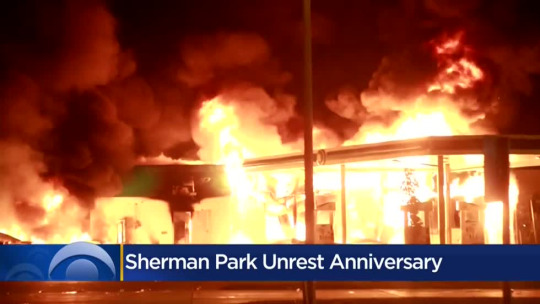
Following the Murder of Syville Smith by MPD in 2016, Sherman Park erupted in flames and the uprising that ensued lasted for 3 days. Rioters looted and burned down a BP gas station. This was not senseless or random; Black community members had been frequently profiled by owners of this particular BP station, and frequently had Milwaukee Police Department (MPD) called on them. A month before the murder of Smith, an employee fired a gun in the air to intimidate a group of teenagers standing in front of the store, claiming that he feared for his life. As rioting progressed, rocks were hurled at local law enforcement, a bank was set ablaze, and a local liquor store was looted. The city of Milwaukee was transfixed, yet what followed in the wake of that moment seemed a dizzying blur: over 2-3 years, conversations shifted abruptly from police brutality, racism, and state violence to entrepreneurship. Almost as quickly as it happened, outside investors swooped in to develop what is now known as Sherman Phoenix, a collection of 30 Black-owned businesses housed within the former BMO Harris bank that was burned down during the riots.
Before this shift, Sherman Park resident and youth mentor/activist Vaun Mayes was framed by both MPD and federal agents for the attempted firebombing of the District 7 police station at the height of the riots. Though the case against him remains ambiguous in its resolution, Mayes’ case and eventual release from state custody garnered him an abundance of local media attention, alongside undue credit as a reliable community activist. Soon after that ordeal, Mayes began dubbing himself “Milwaukee’s Malcolm X”, though his politics were moderate and inconsistent. His influence would later play a role in stunting Milwaukee’s 2020 protests.
The officer who killed Sylville Smith was acquitted of the murder; however, he was discharged from MPD and spent time in prison for a series of sexual assaults. In 2020 Smith’s family was awarded a $4 million settlement from the City of Milwaukee. Over the past 10 years, Milwaukee has spent $40 million on police misconduct settlements. This is not justice, it never will be. Justice cannot exist for Black folx within this system, our own hands must forge a new path.
Non-profits: The Worst Jobs We’ve Ever Worked (CW: Rape, Sexual Assault)
Milwaukee non-profits are closely linked with MPD. More often than not, they aid in advancing the carceral state through partnerships and broad coalitional work. One member of our collective was introduced to the NPIC when they were 16 years old by members of the ACLU Wisconsin when the latter visited their high school classes to speak with students about their civil rights and electoralism. By the time our comrade hit 19, they had dropped out of college and had their first real experience working in the NPIC through an AmeriCorps program. They were paid $17,000/year and received additional food stamp benefits. For how little was paid, it could be argued that work involving social services and the NPIC is a twisted type of exploitation that normalizes the commoditization of marginalized peoples’ experiences even as it normalizes the extraction of their labor and their harassment/abuse within NPIC structures.
During their stint with this organization, our comrade worked directly with women involved in street-based prostitution. In this supposed “harm reduction-based” approach, our comrade was often forced to work directly with police to maintain the symbiotic relationship their employer held with district attorneys, the House of Correction (a county jail that falls under the Division of Adult Institutions but operates somewhat independently from them), and law enforcement organizations (LEOs) writ large. This placed our comrade and other workers in the impossible position of offering little material or social supports to trafficking victims in exchange for tracking them and discussing their cases regularly with police and community members that viewed the presence of trafficked women as a “blight.”
Our comrade remembers their time with this organization as one of the most traumatic periods of their life. As they worked to provide compassionate and appropriate care to victims of sexual violence, sometimes in emergencies, they were simultaneously experiencing violence within their org that overlapped the violence they were expected to help combat in the streets. Gender-based harassment from supervisors and assault at the hands of a co-worker some months into the job, coupled with the daily trauma absorption of the job, eventually took its toll; our comrade’s mental health declined, as did their performance, and they were let go. They recall there was relief in that moment and remained unemployed for a few months while seeking therapy to heal.
Another comrade never even made it that far. As a transplant, this comrade with years of nonprofit experience working with youth and other marginalized communities, decided to volunteer with various organizations to gain both a better map of the city and to better understand where they could apply their passion effectively. Despite becoming a dues-paying member of at least 2 supposedly radical orgs, the only jobs they were being told about were ones that would exacerbate pre-existing health problems. Through 2 different periods of homelessness, this comrade still managed to show up and organize or lend support wherever they believed good community work was being done. Eventually, our comrade’s persistence and organizing chops developed, and the local NPIC began sniffing around.
Our comrade began being flattered and specifically invited to “brainstorming sessions,” a quirky Milwaukee euphemism that essentially serves 3 functions for nonprofits: the first is crowdsourcing language and popular-if-inconsistent definitions of social problems; the second, to pull in and start cultivating so-called leadership skills in individuals who may be able to be exploited by nonprofits through low-pay positions or as uncompensated volunteers; the third function being pure extraction, wherein community members are invited to rough out projects or initiatives that grassroots formations seldom can bankroll, but pose no financial risk to NPIC orgs that regularly receive millions from the state to water down and scale up.
Catching onto the grift, however, is not always a guarantee that one’s boundaries around labor would be respected. When our comrade began politely declining invitations to these brainstorming sessions, they were eventually lured into applying for part-time positions with the same organizations that would allow them to keep their health benefits while earning an income, which made our comrade eagerly apply to all. Experience notwithstanding, our comrade found that the fishing expeditions of the brainstorming sessions were not yet done with them: though it took the better part of a year, during which our comrade filled out multiple applications, underwent numerous background checks, weirdly intensive demands for outlines of programming they had not yet been hired to facilitate, and oddly probing interviews with the occasional direct questions about their anarchist leanings, our comrade realized that these nonprofits had no intention of hiring them so much as simply extracting their labor - as well as intimate personal information - under the guise of community building. Some years after the compliments stopped, our comrade simply withdrew from the NPIC and organizing publicly, preferring to work only with those who respected their boundaries. For a disabled person who could not leave their home much, severing ties to the NPIC represented an end to the social life they badly needed for their well-being.
Abolish the NPIC, Abolish the Celebrity/Career Activist and Black Misleadership Class
NPIC culture demands much from marginalized workers while offering very little in return. Non-profits market themselves as more “just” or “equitable” workplaces for marginalized peoples, but often, they just offer the same capitalistic shit gilded in the rhetoric of false radicalism. In this way, the NPIC exploits the desires of those who wish to build a better world and change the material conditions of oppression knowing they never will be able - or inclined - to address oppression at its roots. Non-profits that portray themselves as “radical” or “revolutionary” are actively lying. The NPIC is an apparatus of an imperialistic, white supremacist, ableist, capitalistic state. It serves to redirect radical energies into neoliberal, ineffectual organizing methods. Its function is to maintain the status quo; those who disrupt or refuse to sell out are pushed out.
One of the worst byproducts of the NPIC and social media culture is the production of the “celebrity activist” or “career activist”. What we're describing is nothing new - sellouts have existed across generations. It’s become more complicated, nuanced, and insidious with the appropriation of radical aesthetics and language. When we think of this type of sellout, elements of George Jackson’s criticism against Bill Cosby and Black capitalism are applicable nearly 50 years later. “Black capitalism, black against itself. The silliest contradiction in a long train of spineless mindless contradictions…We can never learn to trust as long as we have them. They are as much a part of repression, more even than the real live, rat-informer-pig” (George Jackson, Soledad Brother, p. 237). The Black celebrity/career activists are rooted in the ideology of Black Capitalism, tainted by entrepreneurial (bourgeois) aspiration, and opportunism. Their politics are shallow and unprincipled. Coming out of the George Floyd Rebellion, one of the most prominent and glaring examples of this is Patrisse Cullors and the mishandling of donations made to the BLM (Black Lives Matter) Foundation. Despite being a “trained Marxist”, Patrisse accepted deals with Cadillac and owned several million-dollar homes while chapters of BLM struggled to organize on the ground. Patrisse profited in one of the most direct ways possible from the deaths and oppression of Black people. How many more Patrisse Cullors types do you need to see?
During protests against the police killing of Alvin Cole in Wauwatosa, Jay-Z’s Team Roc took the opportunity to generate positive press for the brand, posting bail and covering legal fees for those arrested, including Alvin Cole’s family. The celebrity also took out a full-page ad in the Milwaukee Journal Sentinel calling for Alvin Cole’s murderer, Joseph Mensah, to be prosecuted. Additionally, Tamika Mallory made an appearance, offering a performative press conference. While support from celebrities like Jay-Z may appear beneficial on a surface level, the ultra-wealthy do not and will never sustain social movements or revolutionary activity: Jay-Z has repeatedly shown his allegiance to capital, and his support aims to co-opt the energy of mass movements and encourage the Black masses to buy into myths of Black Capitalism.
In Elite Capture by Olufemi O. Taiwo, the author references the work of Frantz Fanon, Jared A. Ball, and Franklin Frazier to elaborate on myths of the “Black Economy” and Black buying power. In describing African middle classes in post-colonial Algeria, Fanon postulated that this middle class would “capture, dilute and ultimately subvert the energy of anti-imperialist struggle.” Taiwo notes that Fanon’s prediction came to be, “The national independence movements supplanted formal colonial rule only to run headfirst into neocolonialism: a condition in which those young nations’ new ruling elite were either sharply constrained by or actively colluding with the corporations and governments of the former colonial powers - and the international system they dominated.”
Taiwo goes on to analyze Franklin Frazier’s Black Bourgeoisie and the idea of escaping racial strife through a separate Black economy, citing Booker T. Washington’s National Negro Business League. “The combined net worth of all 115 attendees at the inaugural National Negro Business League did not amount to even $1 million. By the time Fraizer wrote his book, more than six decades later, all eleven Black-owned banks in the nation combined did not represent the amount of capital held in the average local bank in smaller white cities.” Drawing from Ball, Taiwo concludes that investing in the idea of a Black economy is politically naive, a fruitless endeavor that would need to be birthed of our current political and economic reality of white supremacy and racial capitalism. He notes that myths of Black buying power and financial literacy only serve to place the onus on the poor instead of on the exploitative nature of capitalism. We see the myth persist to this day through endeavors such as Killer Mike’s Greenwood “Bank”. “The possibility of an insulated Black economy is the myth, while the immediate interests of a few well-positioned Black Folk provide the true impetus.”
For petty bourgeoise aspirationals and the ultra-wealthy, the NPIC provides the perfect platform for the co-optation of our mass movements. Protests become photo opportunities; elements of resistance and revolution are appropriated to market an individual's brand or NGO to philanthropists, funders, and sponsors. Brand recognition is key. Locally, we’ve witnessed executive directors and NGO boards claim police abolition, only to turn around and hire ex-police officers to perform union busting on their behalf. We’ve seen blatant misogynists and homophobes win the title of “Activist of the Year” throughout a near-endless stream of self-congratulatory awards ceremonies. Milwaukee suffers an ongoing plague of micro-celebrity activists, bolstered by an NPIC culture that actively blocks opportunities for effective, revolutionary organizing. Our point is simplistic, the conclusion feels trite, but it’s a message Milwaukeeans need to hear. If any real work is to get done, the NPIC and career/celebrity activism need to be abandoned or eventually destroyed.
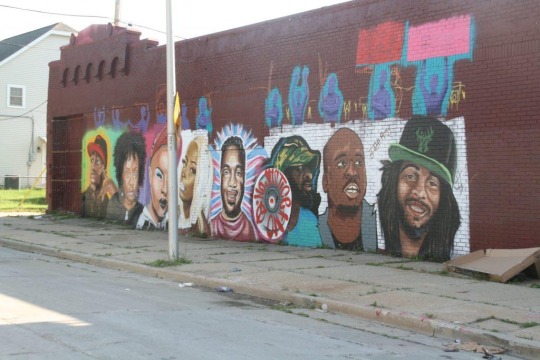
(A mural that recognizes “leaders” involved in Milwaukee’s 2020 protest movement…the mural depicts Frank Nitty, Sam Alford, Khalil Coleman, Jeremiah Thomas, Elle Halo, Tommy Franecki, Markasa Tucker, and Vaun Mayes.)
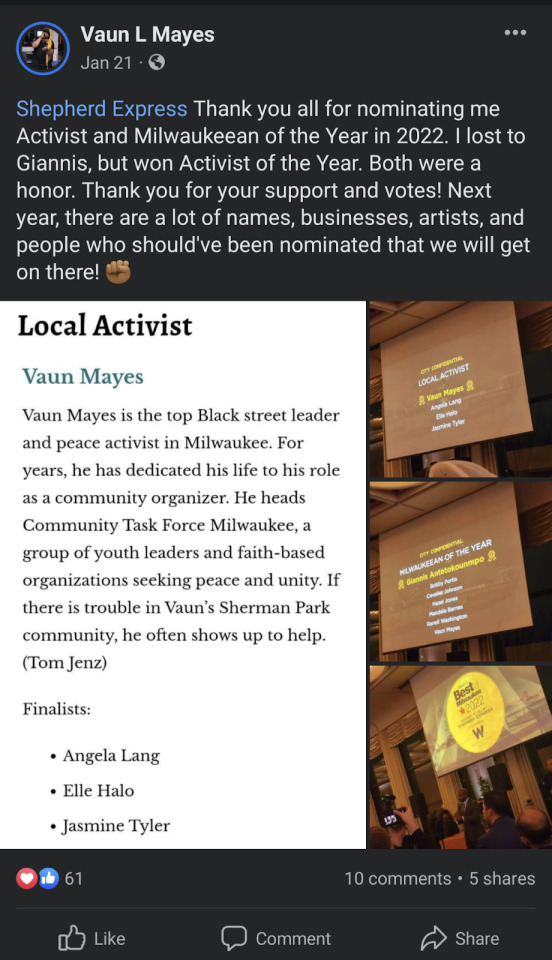
*Note: Some non-profits do excellent work, and are well respected within the communities in which they operate. The non-profit legal structure can be used as a tool that allows grassroots and anarchist formations to operate more freely. However, within a $2 trillion industry employing 10% of the United States population, we find the types of non-profits mentioned above represent a microcosm within a majority. Members of our collective understand the benefits and contradictions of being involved in the NPIC as we have worked within the field and received services from the NPIC. This is not a judgment of those involved within the NPIC structure, it is a call to think critically about the structure.
How Milwaukee Got a Youth Prison: Past to Present (CW: Sexual abuse, Child abuse)
Milwaukee’s NPIC is deeply connected to the carceral justice system and policing, and many violence prevention programs and non-profits are incentivized to work with the police to receive funding from the city. Unsurprisingly, local non-profits ushered in a new youth prison in Milwaukee. To explain how this all came to fruition, we’ll need to lay some ground and talk about the Lincoln Hills and Copper Lakes crises that occurred over the course of a decade. Tracking everything that occurred at these facilities could amount to a separate book on its own, so we'll only be tackling a tiny fraction of events in this section.
According to the Milwaukee Journal Sentinel, the problems began in 2010-2011 under Republican Governor Jim Doyle’s administration. The number of youth prisoners had steadily decreased over the years and in 2011, inmate populations dropped to half of what they were in 2004. For the Doyle Administration, it financially did not make sense to continue running three separate facilities (Lincoln Hills located in northern Wisconsin, Ethan Allen School in southeastern Wisconsin, and Southern Oaks Girls School in southeastern Wisconsin): Lincoln Hills operated at a much lower cost than the other two facilities and state law mandated that a juvenile facility must remain open in northern Wisconsin. This law did not apply to southeastern parts of the state, where most of Wisconsin’s Black and incarcerated population stemmed from. By January 2011, Republican Governor Scott Walker was instated; he moved quickly to close Ethan Allen School and Southern Oaks Girls School, consolidating 100 prisoners into Lincoln Hills and doubling the prison population. Lincoln Hills was extremely short-staffed, the sparse population of northern Wisconsin being to blame. The Milwaukee Journal Sentinel stated, “...juvenile justice experts around the nation were recommending smaller, more localized facilities, Wisconsin went in the opposite direction, consolidating operations in a remote setting.”
In February 2012, Racine County Circuit Judge Richard Kreul sent a memo to Scott Walker detailing a case of abuse. ”The memo Kreul sent to Walker described an incident in which an inmate from Racine was forced to perform oral sex on his roommate and then beaten unconscious. Workers learned of the assault at 4 p.m. They didn’t get the victim medical treatment for three hours.” [Milwaukee Journal Sentinel]. In 2014, when Milwaukee-based Public Defender Robin Dorman learned that one of her clients was not receiving medical treatment or being sent to classes, she quickly learned that her client was not alone. Upon discovering additional allegations of abuse and neglect, Dorman sent a memo to Milwaukee County Chief Deputy District Attorney Kent Lovern, who forwarded it to the Department of Corrections. By January 2015, a criminal probe was launched to investigate Lincoln Hills. What the investigations would unveil was deeply disturbing.
Most of the youth held in the facility were Black children from Milwaukee, though the facility was located in Irma, WI - 215 miles away from Milwaukee (a 3.5-hour drive). Horrendous abuse and corruption plagued these facilities, ranging from physical child abuse to suicide, and sexual abuse and harassment of minors. The Milwaukee Journal Sentinel details the conditions inside the facilities, describing a teen who had his foot crushed by a prison guard. “Inside his room, Evans screamed and held up his foot so the staff could see the bleeding. The Milwaukee teen had lost parts of two small toes, but it would take prison officials nearly two hours to take him to a hospital 15 miles away.” Another incident involved a psychologist commenting on a teen girl's breasts, stating that they looked "rode hard and put away wet." The investigation also revealed that the prison’s lead trainer taught staff to pin inmates by putting their knees on inmates' backs - a technique that could cause suffocation and death. This trainer did not contact nurses when inmates were injured. There were 4 incidents where inmates had broken bones. By December 2015, the facility was raided by 50 state agents and the investigation was turned over to the FBI. Over a dozen staff members quit, were fired, or retired. A $25 Million settlement was reached for those who stayed at the facilities.
In 2018, Governor Walker announced a plan to dissolve Lincoln Hills into 5 smaller prisons spread out across the state. In April 2022, Democratic Governor Tony Evers signed a law that would bring a prison to Milwaukee. By January 2023, Milwaukee Common Council approved the zoning for a new youth prison to be built on the predominantly Black northwest side of Milwaukee. The Facility will not be operational until 2026. The decision was made to put the youth prison in a district that completely lacks an alderperson at the time of this writing (the previous alderwoman, Chantia Lewis, was removed from office after pleading guilty to embezzling $20,000 in campaign funds). Residents were taken off guard by the development of the prison and a majority opposed it, citing the potential decrease in property values as their primary concern. Many non-profit leaders spoke out in support of the facility's relocation to Milwaukee’s northwest side, however, framing it as a way to bring the youth inmates from Lincoln Hills “home”. Sharlen Moore, co-founder of the non-profit Urban Underground and youth justice advocate stated, “We have to figure something out. We have to put them somewhere.” Representatives from the non-profit Ex-incarcerated People Organizing (EXPO) echoed Sharlen’s sentiment. There are currently 69 youths that remain at the Lincoln Hills and Copper Lakes facilities. Alternatives to prisons exist, we’re dealing with people, not objects to shuffle around or “put somewhere.”
George Floyd Rebellion of 2020: A Clusterfuck
During the George Floyd Rebellion, the lack of solid organizing and security culture in Milwaukee led to Black misleadership and celebrity/career activists seizing control and altering the trajectory of a radical movement into neoliberalism along a counter-revolutionary line. The People’s Revolution (TPR) was formed in the early days of the George Floyd Rebellion and was initially spearheaded by Frank Nitty, Vaun Mayes, and Khalil Coleman. These “leaders” quickly proved dysfunctional, as accusations of homophobia and misogyny bubbled to the forefront almost immediately. Throughout 2020, we talked with individuals involved in TPR’s protests and though accounts varied from person to person, what we picked up on overall was that TPR’s leadership fostered an environment that made protests feel unsafe for Black women and queer individuals. On June 12, 2020, TPR leadership was called out in a Facebook live stream regarding accusations of misogynistic and derogatory language used toward queer protestors. While Vaun Mayes showed up to the live stream for “accountability”, Frank Nitty and Khalil Coleman did not. There were repeated attempts to reach out to Frank and Khalil, which seemed to be met with hostility. The presence of misogyny and homophobia are major red flags for any group claiming to be revolutionary. The Facebook Live stream did not provide the accountability process needed to change course. In an ideal world Frank, Vaun, and Khalil would have stepped down from their leadership positions within TPR and undergone a serious accountability process that involved their removal from movement and protest work, if only until genuine efforts towards transformation had occurred.
The effects of misogyny and what we’ll call “weak link politics” have been touched on repeatedly in writings such as Why Misogynists Make Great Informants, by Courtney Desiree Morris, and Basic Politics of Movement Security by J. Sakai and Mandy Hiscocks. As Morris succinctly points out, “There are serious consequences for choosing ignorance. Misogyny and homophobia are central to the reproduction of violence in radical activist communities. Scratch a misogynist and you’ll find a homophobe. Scratch a little deeper and you might find the makings of a future informant (or someone who just destabilizes movements like informants do).” In Basic Politics of Movement Security, Sakai details the story of an FBI informant known as “Tom” who played a role in destabilizing the Black Panthers. Tom got in with the Black Panthers by appealing to patriarchal values. Sakai recounts Tom being called out by a group of local women on suspicion of being an informant, “Oh, its politics that’s so hard for me to learn, ‘cause I had no education… I wanna learn, I’m sorry, give me another chance.” Tom rebuffed in a way that is somewhat similar to the accountability dodging Mayes did during the live stream referenced above. “I am ignorant to a lot of shit, you know? …as far as being a straight male versus y’all community (the LGBTQ+ community), there's a lot of shit I don’t understand… I don’t primarily deal with y’all community.”
We don’t draw this comparison to accuse Vaun or the former TPR leadership of being outright informants. Practically speaking, there’s no way for anyone to know unless evidence explicitly demonstrates otherwise. The point is not to badjacket or drum up needless suspicion. However, we draw the comparison to accentuate that an individual's politics, actions, and consistency should be examined with a discerning, critical eye. Trust and access should not be easily given to those who consistently show up with weak link politics. Sakai states, “...Security is not about being macho vigilantes or being super suspicious… Security is about good politics. That's why it's so difficult. And it requires good politics from the movement as a whole. This is demanded of us… Bad politics covered for agents…it’s that bad politics - like opportunism, patriarchy, sexism, and class privilege - rips up the fabric of our terrain, the area of our radical culture, and weaves it instead into that terrain all their old oppressor politics, their values.”

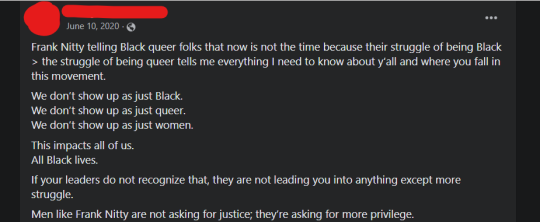
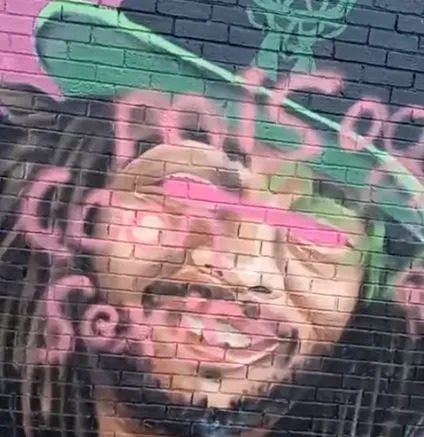
[Defaced mural of Frank Nitty with the words “misogynistic coon” and “sexist” spray painted across it.]
TPR slowly unraveled throughout the rebellion. Despite appointing themselves revolutionaries, TPR operated in multitudes of obvious contradictions. They frequently partnered with local elected officials and pushed electoralism, lobbying, and reform as a method of “revolution”. State representatives such as David Bowen and Jonathan Brostoff publicly aligned themselves with TPR, and attended marches consistently. “They use their resources to help as many people as possible and to push the system to be accountable, especially to Black and Brown people,” said David Bowen to Milwaukee Magazine in September 2020. The excess media attention around the George Floyd Rebellion provided the perfect stage for stooges to bolster their platforms and appeal to potential voters. While electoralism and aligning oneself with the state may seem like a clear pitfall to an experienced organizer or theorist aligned with revolutionary/liberatory movements, it bears explaining to those less familiar. Aligning oneself with politicians, elements of the state, or electoralism is explicitly counter-revolutionary:
“It isn’t revolutionary or materialist to disconnect things. To disconnect revolutionary consciousness from revolutionizing activity, to build consciousness with political agitation and educational issue-making alone is idealistic rather than materialist. The effect has been reformism rather than revolution. When any election is held it will fortify rather than destroy the credibility of power brokers. When we participate in this election to win, instead of disrupt, we’re lending to its credibility, and destroying our own.” (George Jackson, Blood In My Eye, Pg. 26)
TPR’s leadership brought forth a movement of cooptation, empty symbolism, and misdirection. It is no surprise that Vaun Mayes has recently aligned himself with MPD post-rebellion, advocating for increased police surveillance through ShotSpotter technology. According to Sheperd Express, ShotSpotter is an acoustics-based technology that locates potential gunshots via impulsive sound. The contract with ShotSpotter has cost the City of Milwaukee $3.7 million over the past 13 years. “I’d like my ComForce team to get access to ShotSpotter because when we hear shootings in our neighborhoods, it is sometimes difficult to find the location...We are here to help the police and protect the residents, and we are expanding…I think we are setting a standard on how true collaboration and unity is supposed to look. We want to work with the police,” said Mayes, referring to Community Task Force (ComForce), a non-profit he helms which regularly partners with MPD.
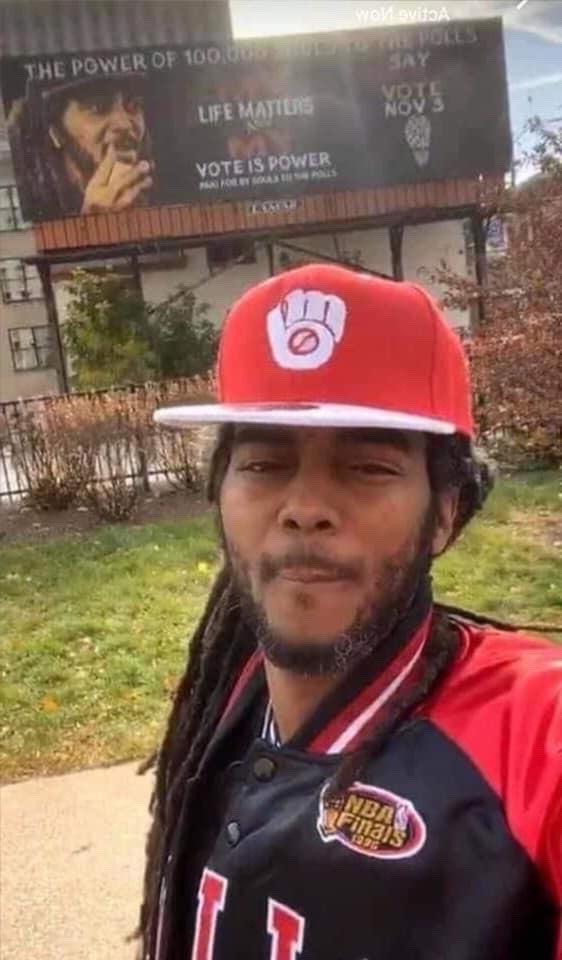
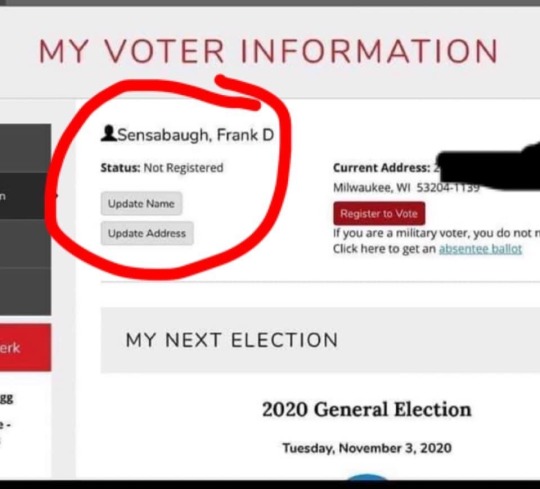
[Photo of Frank Nitty next to a billboard advertisement of himself promoting voting, despite not being registered to vote himself.]
From a security culture standpoint, TPR’s practices were negligent and put protestors at risk. TPR’s marches often lacked street medics, leadership constantly live-streamed their whereabouts, and TPR provided little to no recourse, such as bail funds or free legal representation, for those arrested. Leadership also folded in with the likes of fascist groups such as the Bugaloo Boys, posing as street medics for TPR. The effects of this negligence culminated when the rebellion reached Wauwatosa and Kenosha. According to The Daily Montanan, Wauwatosa Police Department (WPD) managed to create a list of over 200 protestors, and a good portion of that list included members of TPR, as well as people who marched in solidarity with them. The list was created by Dominick Ratkowski, a crime analyst for WPD, and was utilized as early as mid-July 2020. The list was circulated amongst MPD, KPD (Kenosha Police Department), and the FBI office in Milwaukee. Up to 12 agencies received the list. Members of TPR were mailed tickets as high as $1300. The Daily Montanan reads, “On Aug. 28, Gibson (Milwaukee DA Investigator) asked for any lists or photographs of protesters to share with Kenosha. On Sept. 15 the list, which had been shared by Ratkowski, was sent to Kenosha PD Detective Pablo Torres, who worked for the department’s Special Investigations Unit at the time. ‘Here is an updated list of the subjects identified as members or associates of The People’s Revolution,’ Gibson’s email reads.” The screenshot below does not prove that Coleman or TPR leadership was feeding members' information to law enforcement agencies; it is mere conjecture, but we cannot dismiss it as a possibility.

[This post was made on September 1, 2020]
Regardless of whether the intent was malicious or not, a lack of security practices essentially had the same effect as an informant or wrecker: TPR members and leadership had been arrested at several points during the rebellion, and during any of these arrests, police could have confiscated their cellphones to collect intelligence on members and associates. This is why maintaining anonymity is key - never bring a cell phone to a protest, and never record yourself or others engaging in protest activity. Your identity should be your most protected asset. Cover tattoos, piercings, or other identifying features and always wear plain, unbranded clothing. Consider utilizing a pseudonym during protests. Always remember your cell phone and other pieces of technology can act as a cop, and avoid the potentiality of surveillance as much as possible.
Our advice for those participating in protests and riots is to return to analog styles of communication (written notes, utilizing walkie-talkies, communicating face-to-face, implementing coded language, etc). Detailed in episode 8 of the Alphabet Boys podcast, an FBI program known as “Social Media Exploitation” was utilized during the George Floyd Rebellion. This program allowed the FBI and local law enforcement agencies to mine social media accounts and create files on individuals without probable cause. The host of Alphabet Boys, Trevor Aaronson, goes on to detail the story of a woman charged with a crime for throwing her bike down near a police officer. She was captured on a police body camera and identified by law enforcement through social media posts, specifically by matching photos of her biking gear with her attire in the video. Police were able to attain a warrant to search her home and she was charged with attempted aggravated assault of a police officer, a second-degree felony. Police reforms, such as body cameras, are weaponized against those who dare to resist the state. If there is a will to charge you with a crime, there is a way. People should always keep in mind that their social media presence is likely being monitored and should try to practice good digital hygiene. Intentional mass arrests are an outdated tactic of the ‘60s and ‘70s; in the present day, arrests should be avoided if possible - you do not want to be logged into any state system as it makes it easier for law enforcement to target and track you for an indeterminate length of time.
Ultimately, TPR’s influence managed to assimilate many young people into their organization, placing youth directly in harm's way. This disillusioned, traumatized, and embittered many young people. Tyrone Randall, a participant in TPR’s protests, was pinned by police, left on the ground, and struck by a car. Tyrone was left with broken ribs, a broken pelvis and thousands of dollars in medical debt. TPR’s failures fostered an environment that made many reluctant to return to grassroots organizing as a whole. Former members and youth of TPR were quickly assimilated into the NPIC once the organization grew stagnant.
Post-George Floyd Rebellion: Where are these niggas?
Post-rebellion TPR quickly dissolved, and few of the former leadership remain active. In April 2022, Khalil Coleman was found guilty in the first degree for a robbery that took place in Kentucky in February of 2021. Coleman attempted to rob a trap house with the coerced aid of a minor and was later sentenced to 10 years in prison. Coleman maintains that he is innocent via Facebook posts, and he has been soliciting support for his appeal through an online petition.
Around August 2020, Frank Nitty led a March from Milwaukee to Washington D.C. In the immediate aftermath of this commemorative journey, several scandals began to surround Nitty. Rumors of Nitty stealing and mishandling donations circulated on social media, which led to some accusing him of using the funds to take white women on dates. Additionally, a Facebook group of “sister-wives,” boasting nearly 200 members at one point, formed around Nitty. All jokes aside, around November 2020, Nitty was accused of sexually assaulting four separate women. He was arrested and held in jail for a short period before his bail was posted, and charges were never brought against him. After 17 months, prosecutors decided that there was not enough evidence against Nitty between the four women who accused him and dropped the charges completely. Based on Nitty’s history of misogyny, we believe the women who accused him. Nitty’s whereabouts and current activity remain unclear, as he has seemingly disappeared from Milwaukee altogether.
Vaun Mayes remains active in Milwaukee’s non-profit and organizing scene: He currently remains a leader of ComForce, engaging in ambulance chasing. Vaun has continuously aligned himself with the police, local politicians and even noted transphobe/huckster Dr. Umar Johnson.
Conclusion: Wrapping this shit up
2020 demonstrated that Milwaukee is not politically prepared to resist the rising tide of fascism. It is a frightening position to be in considering that the RNC (Republican National Convention) is coming to Milwaukee summer of 2024. The fascism Black people in Milwaukee have had to face has primarily been institutionalized, moderated through politicians, policing, prisons and racist state/city policy. The city has rarely had to face off directly against fascist demonstrators. There is no dedicated Black Bloc or anti-fascist presence prepared to push back against the fascists that will come to gather in Milwaukee summer of 2024. The city is seeking to import nearly 4,500 officers to Milwaukee for the convention. Frankly, we wouldn’t recommend an outright counter-demonstration against the 2024 RNC. Marginalized people should stay home the day the RNC comes to town. Those interested in preparation should get street medic training, and learn how to treat gunshot wounds. Black communities situated directly near the RNC should prepare their neighborhood or block in community self-defense tactics. Prepare for violence but do not seek it out.
Strategically there are stronger opportunities for resisting. The youth prison coming to Milwaukee’s northwest side should be resisted, and the youths that remain captive in Lincoln Hills should not be abandoned in cages of the state. A non-carceral solution is desperately needed. We're not sure what the exact solution looks like for Milwaukee, but answers have already been conceptualized in writings such as Instead of Prisons by the Prison Research Education Action Project. The text details an experiment done in Massachusetts in 1972 to decarcerate the state’s juvenile prison system. The majority of youths returned home on parole, some were sent to a local university to work with a student advocate for a month. The text continues, “The administrative system was decentralized, with seven regional offices set up to make all decisions about individual youth placements and needs. Almost all services for the juveniles were contracted from private agencies, resulting in the creation of a wide range of community programs.” It advocates cutting ties with the criminal justice system, including instances of parole and probation, releasing prisoners to community-controlled support and peer groups on a case-by-case basis instead. The writers advocate that instead of serving the rest of their sentences, former prisoners should be involved in restoration processes. The strategies mentioned above are intermediary steps towards prison abolition. The authors note:
“We caution strongly that all interim as well as long-range strategies be considered only after conferring with knowledgeable prisoner and ex-prisoner groups. Interim policies crucially affect the lives of prisoners still inside the system and many ex-prisoners on the streets. What seems a paltry and therefore unacceptable change to those outside the wall, might be a highly significant and desirable change for those who are caged or under control in the streets. If there are differences in strategies between prisoners who have experienced the day to day reality of prisons and prison changers who have not, take the time to hammer out differences and reach agreement. Strategies and tactics that are not in unity weaken the total movement toward systems change.”
People interested in building a truly revolutionary movement should study the principles and histories of anarchism, the Anarkata turn, Black radicals, and anti-state communism within groups. White organizers need to step back and follow the lead of Black radicals or get out of the way. Deprioritize the visibility of individual organizers and the mindset of individualized leadership or hierarchies. The aim should be an anonymous and autonomous mass movement of free association that centers issues of the most oppressed, the most marginalized, the problems of the lumpen/lumpen-proletariat (Black, QTGNC folks, those living with disabilities, the poor, the houseless, etc…). The organizing methodology outlined in Move Like Mycorrhizae from Afrofuturist Abolitionists of America, demonstrates best practices. Organizing in this way provides a layer of security and protection from opportunists, clout chasers, and potential informants or state agents.
We can’t tell you what to study, what to do, or how to organize. We can only suggest that anyone who reads this zine study past and present liberation movements of colonized people, both within and outside of the United States. Learn where others have failed or succeeded. If the conditions are right, repeat what has proven successful and try not to repeat mistakes. It's the principle of Sankofa; meaning “go back and fetch it” - take what is useful, leave behind what is not. Studying, organizing, and remaining principled in the liberation struggle is a lifelong commitment. We’ll never stop learning; movements will change, tactics will change. New theories and organizing methodologies will need to be established from the foundation of what previous Black radicals left behind. Studying and organizing alongside BARs (Black Anarchic Radicals) and the Anarkata turn guided us to our current political trajectory. We don’t believe in authoritarian methodologies, cults of personality, or that Black people need a “leader” to effectively organize and win. There will be no vanguard to lead the masses to revolution, nor is it the role of the political theorist.
Frantz Fanon stated,
“To educate the masses politically does not mean, cannot mean, making a political speech. What it means is to try, relentlessly and passionately, to teach the masses that everything depends on them; that if we stagnate it is their responsibility, and that if we go forward it is due to them too, that there is no such thing as a demiurge, that there is no famous man who will take responsibility for everything, but that the demiurge is the people themselves and the magic hands are finally only the hands of the people.”
As the tide of fascism rises, as climate change accelerates, as technocratic corporations advance, as living conditions under capitalism worsen - political and state repression will become more visceral. We saw it in 2020, with state agents snatching protestors off the streets in unmarked vehicles. We saw it in Kenosha when local law enforcement stood in league with fascist armed militias. We’re seeing it in motion with the development of Cop City in Atlanta, a project with international implications to further militarize the police, preparing them for urban warfare with citizens. If there is any time to gain urgency, to connect and organize within your community, it’s now. The politics of capitalism, of fascism, is ultimately a politic of slow death and suffering for the many in exchange for short-term gain and excess for a few. We hope to see the end of this fetid, vile system in this lifetime or the next.
4 notes
·
View notes
Text
No, because people keep acting like Grace Chastity being consumed with a lust for the power that Lords in Black provided her doesn't count as a world ending Cataclysm - but it very much does. Not only has she shown little to no empathy for others throughout the entire show and only ever felt bad for lying to authority figures and being horny - but the final song of the Musical is essentially a reprise of Max's Murder Song/Manifesto which places her as a parallel to Max. Max sings about how he's going to kill ALL the Nerdy Prudes and not once but twice tells the audience that it doesn't matter if someone is actually a Nerdy Prude because he makes the rules and gets to decide who is or isn't a nerd etc etc. Grace's take is that she is going to kill all the Dirty Dudes but she's literally singing it to a guy who has, throughout the entire musical, done nothing to indicate he's a pervy/dirty dude and only kissed her after she asked him too. Like Max, Grace Chastity doesn't actually care if someone genuinely fits the framework of her stated victimology, because she has the power so she gets to make the rules.

Honestly it's like some people didn't think about the implications.
#npmd#starkid npmd#starkid#nerdy prudes must die#grace chasity#max jagerman#nerdy prudes spoilers#npmd spoilers#nerdy prudes must die spoilers#the guy who didn't like musicals#tgwdlm#black friday starkid#starkid musicals#hatchetfield#hatchetverse#hatchetfield musicals#nightmare time#dirty dudes must die#starkid theory#hatchetfield theory#the implications#Promise me you'll think about the implications
3K notes
·
View notes
Text
When MatPat came on screen I freaked out (in a good way) and got so light headed I missed the entire conversation and almost passed out until he said "But that's just a theory-" which shocked me out of it like a sleeper agent code word
#fnaf#fnaf movie#fnaf spoilers#fnaf movie spoilers#matpat#had a good time!#movie was alright. some parts bad. many plot holes#but the animatronic moments were easily the best part and made it super enjoyable#both the sweet moments and the killing moments#i had to ask my friend afterwards why matpat said “that's just a theory” because i did legit almost black out#i haven't watched matpat in years btw
3K notes
·
View notes
Text
James: How do you feel about children?
Regulus: They’re okay, I guess. I mean, if I saw one, I wouldn’t throw a rock at it
James: Why would you throw a rock at a child?
Regulus: I just said I wouldn’t!
#jegulus#you gotta LISTEN james!#james potter#regulus black#incorrect jegulus quotes#incorrect marauders quotes#james x regulus#sunseeker#starchaser#james potter x regulus black#harry potter#incorrect harry potter quotes#daddiesdrarry on instagram#incorrect hp#hp#marauders#the marauders#hp ships#hp text post#hp imagine#hp incorrect quotes#incorrect hp quotes#hp rare pair#regulus x james#incorrect regulus black#incorrect james potter quotes#jegulus squad#source: big bang theory
1K notes
·
View notes
Text
That one Big Bang Theory scene but:
James never loses his composure but sometimes like this when he's tired and lost and doesn't know what to feel, he brakes a little.
James: You LOST my mother's ashes??
The girl that works at the airport:...No...I-I'm just saying that sometimes bags are misrouted.
James: Alright FINE, where did you misrout the only woman who EVER LOVED ME.
--- an hour later ---
The girl: Mr and Mr Potter? As far as I can tell your bag arrived in LA
Regulus: So where is it?
The Girl: Well I don't know, perhaps somebody took it off the carousel by mistake?
James: So some stranger has my mother? It's thar what you're talking about? My poor mother can be anywhere in Los Angeles rightnow?
The Girl close to tears: I- I wish I was telling you that. Uhm but the passenger could have gotten on in an international flight
James: Okay, grate. So...your ENTIRE job is to find lost luggage, and you've narrowed down the location of my mother to the PLANET EARTH
--- James starts to walk away ---
Regulus to the girk: Listen to me very well, you better find my husband's mother's ashes, because one way OR ANOTHER we are walking out with a dead woman. Do you understand?
The Girl:...
Regulus: Do you?!
The Girl: Yes, sir
#regulus black#regulus deserved better#sirius black#james potter#jegulus#starchaser#james x regulus#black brothers#the marauders#marauders era#the big bang theory reference
2K notes
·
View notes
Text
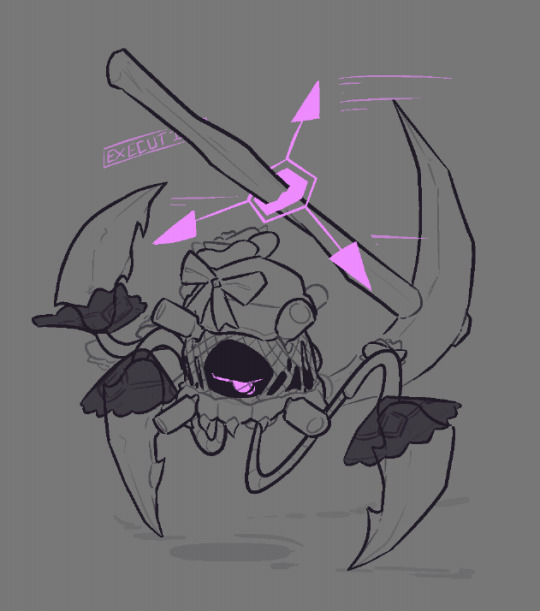
hi heres art so you pay attention to me now go read the tags
#ive been rewatching episode 7 like its the only thing on youtube and made note of many things#first off. the solver can only have one host. nori mentions skyn wants to kill off all the other solver hosts (with the dds) and disregards#the idea of both uzi and doll being its current host when they get chased#plus the main solver possessions only occur when skyn is out of the picture (the fightt in ep 7 is only after n decapitates “tessa”)#solver uzi is possible too but i dont count her cause she doesn't have the yellow#personal theory is that its more an instinctual response to overheating or something and not full on possession#second off nori calls the solver cyn. how does she know that name#cyn was on earth and only showed up to copper 9 recently and i presume nori's been here her whole life#it probably wasn't the other dds cause none of them made it down and they're all more savage beasts#since cyn specifies n's team retained their personalities and that makes me think the other teams didnt#also also we should've immediately questioned tessa arriving in the same type of pod as the mds when they were revealed to not be sent by j#im running out of characters also the people who dont like when i use tags like this can bite me#murder drones#murder drones nori#artori? that sounds cool#ill probably just stick with nori though#i have so many solver heart refs now#art#episode 7#murder drones episode 7#murder drones episode 7 spoilers#using the same black for shadows as my lineart doesn't work when i have to draw thin things over it#murder drones spoilers
1K notes
·
View notes
Text


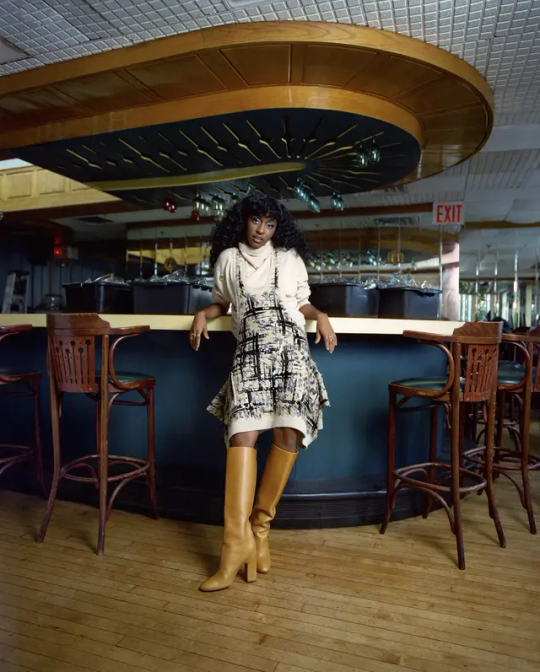


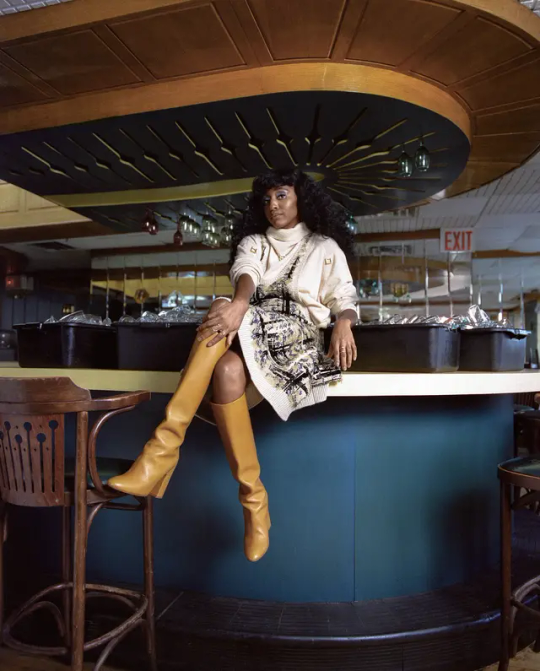


Ayo Edebiri by Myesha Evon Gardner
#Ayo Edebiri#Myesha Evon Gardner#visual art: when Black artists create#color theory#texture: a feeling#light and such#beholding Black intimate geographies#embodiment as grace#there is only wonder in the softness of joy#the coolest marvels in the underspace#and against the haze of the afternoon the softest light
5K notes
·
View notes
Text
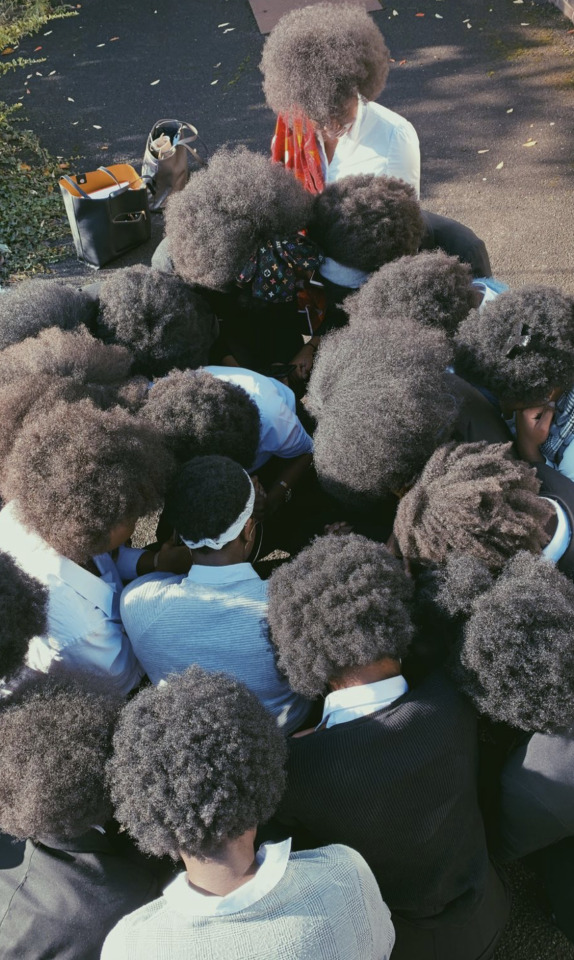
What do you think ?
Do you believe our hair is our antennas? Do you believe that is were we generate our energy ?
#black twitter#black women#blackexcellence#aesthetic#black aesthetic#black culture#black is beautiful#black tumblr#blacklivesmatter#neo soul#conspiracy theories#black truth#antenna#super powers
1K notes
·
View notes
Text
regulus: *hiding james*
sirius: if there’s no one here, why are there two glasses of wine on the table?
regulus: oh, well, you know
regulus: i’ve got two hands and a bit of a drinking problem
#big bang theory#marauders#marauders era#incorrect marauders#regulus black#james potter#sirius black#jegulus
3K notes
·
View notes
Text
If there's one thing TGWDLM fans are gonna do, it's think about the implications. And the implications of the opening number are crazy.
So. We know that the show isn't completely chronological since the opening number takes place before the meteor hits. So that song is a sort of "flash forward" moment. But when you think about it, we don't really know how far in the future it takes place.
What we do know is that by the time it's happening, Emma is infected. She has a little solo in it singing about how Paul is pining over a barista
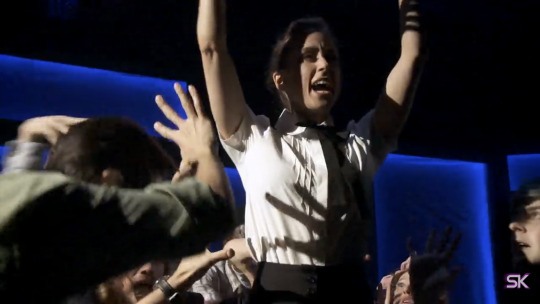
And we know that this is meant to be an infected Emma specifically. Lauren had other characters in the show, if they wanted to avoid the Emma implication they would've just dressed her as one of those.
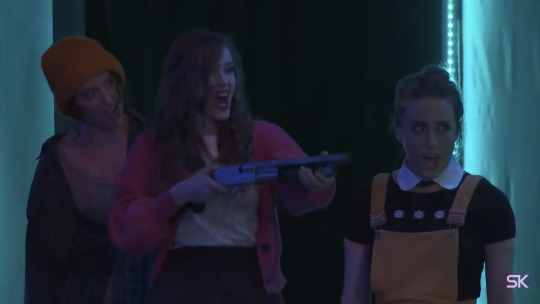
So we know this is meant to be Emma.
And Emma isn't infected until the very end of the show. She's dragged off stage during the credits. So since she's infected in the opening number, we know the number takes place after the events of the show.
Another important detail is that Paul is infected before Emma. He's the one that passes it on to her.
So back to the opening number, Emma is infected. Which means by just following a simple timeline, Paul must also be infected. He should be singing and dancing, right?
But that's not what happens. Paul misses his entrance.

If Paul is infected, then there's no reason he should be missing his entrance. Furthermore, if he's a part of a hive mind, there's no reason other members of the same hive mind shouldn't know where he is. They are literally all connected by one brain, and yet both Mr. Davidson and Bill express they have no clue where he went.
What I'm saying is that Paul is not infected. He was infected (again, we know that because Emma is infected and he was infected before her) but now he's not anymore.
I'm saying there's a way out of the hive, and Paul found it. That's the only explanation that makes sense given the facts of the situation. Sometime after the events of tgwdlm, Paul is able not only to break out the hive mind, but to hide from it.
And if he broke out, others could do the same. Maybe even Emma.
Edit because a countertheory has emerged:
Yes it's possible that everyone is infected the entire time and the show itself is just Pokey replaying the events for the fun of it. But it seems unlikely to me.
First of all, each of the Lords in Black has a distinct personality. They all are evil, but within that they seems to fall somewhere on a spectrum of "silly billy" to "prick." For example, Tinky is more of a silly billy. He toys with humans without much of a motive and more for just shits and giggles. But in every instance, Pokey's more on the extreme side of prick.

He's one of the few with an actual motive behind what he does. In Yellowjacket, it's confirmed that Pokotho hates the sound of anyone's voice except for his own. The events of TGWDLM don't happen because Pokey is bored, they happen because he is executing a plan. So I don't think that he would just have them play out their little scenario just to entertain him, especially just one small island? I just feel like he'd be more focused on world domination.
If the theory is that all this is happening after Pokey's already taken over the whole world, no one was successful in stopping him, then yes it's plausible, but still weird. There are a strange amount of things in that show you just think an eldritch god wouldn't include.
Edit 2: New evidence has emerged???
The Guy Who Didn't Like Musicals is loosely based off of Invasion of The Body Snatchers. Paul's last name is even a nod to the main character, Matthew. At the end of the film, Matthew survives, and continues living among the infected, pretending to be one of them. And wouldn't that be just such a fun little parallel...
Obviously it doesn't prove anything but the source material doesn't lie folks.
#the implications#starkid#hatchetfield universe#hatchetfield#paul matthews#emma perkins#tgwdlm#the guy who didn't like musicals#npmd#black friday musical#theory#fan theory#jon matteson#lauren lopez
2K notes
·
View notes
Text










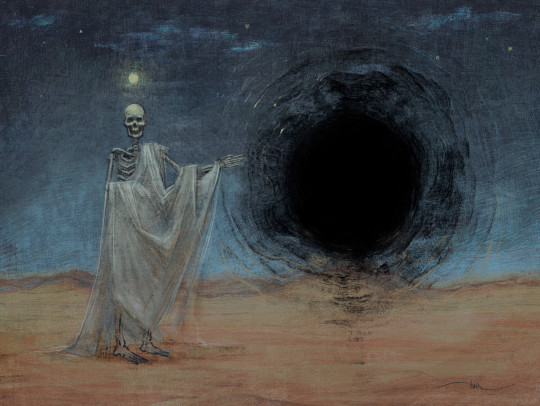
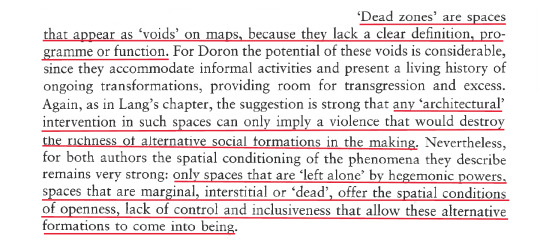
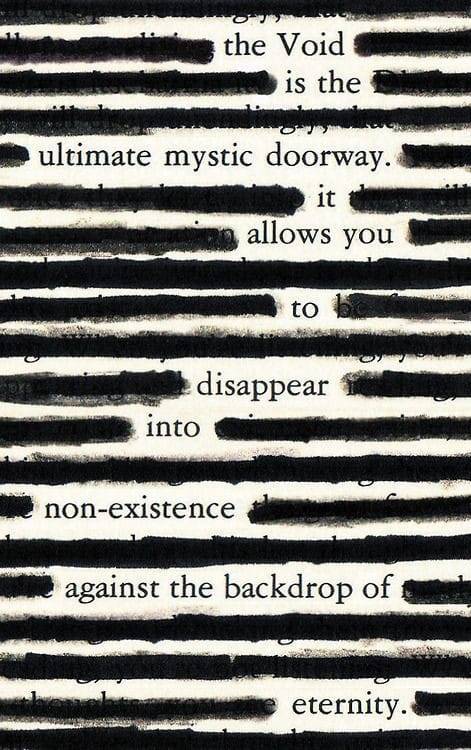
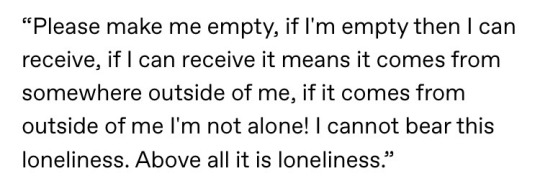



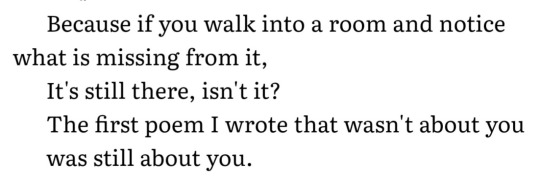
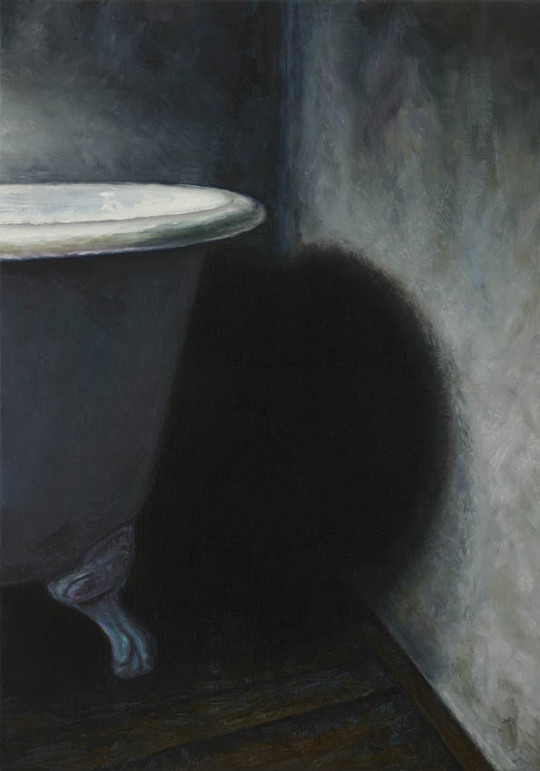


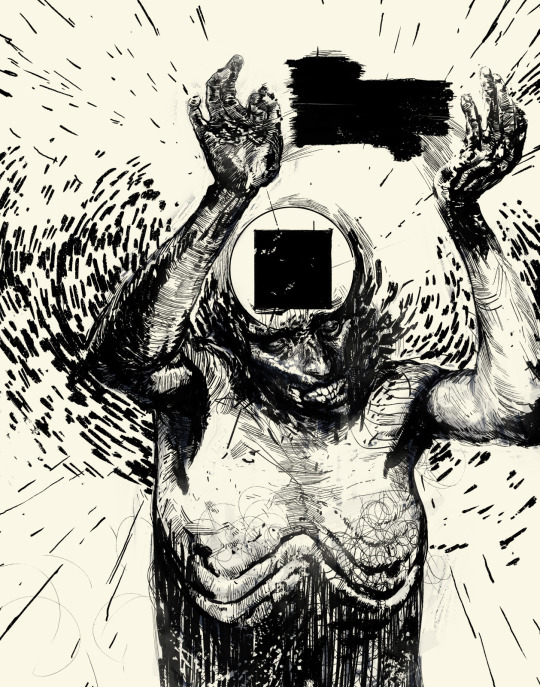
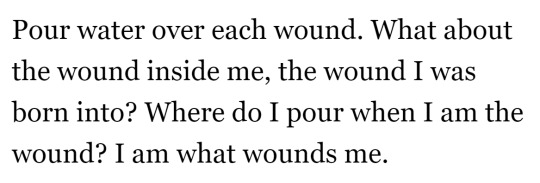




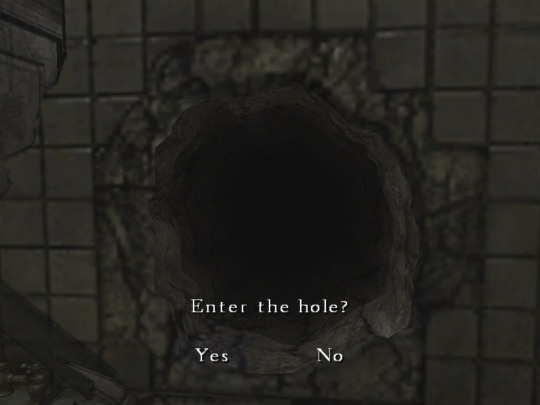
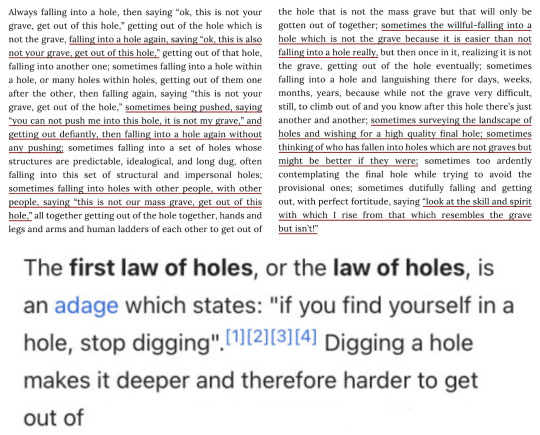

The future is a benevolent black hole.
Sagittarius A* / Kathy Acker, Pussy, King of the Pirates / Outer Wilds (2020) / Is There a God-Shaped Hole at the Heart of Mathematics? / Drain for overflowing water at Sambuco Dam, Lavizzara Valley / ? / Thomasin Frances, Hole Theory (15/10/2022) / Bryan’s Ground, a public garden in Herefordshire on the Welsh border. / odd, weird, strange and unusual / Mark Z. Danielewski, House of Leaves / Illustration of the Annular Eclipse of 1836 from “A fourteen weeks course in descriptive astronomy”, Joel Dorman Steele (1836-1886) / @imdad_barbhuyan on Instagram / The moon’s Copernicus crater. Through magic glasses. 1890. / Kaveh Akbar / Darina Muravjeva, Hole / Hilde Heynen in Heterotopia and the City / x / Leonard Cohen, Beautiful Losers / x / Louise Glück, from Descending Figure / Anne Carson, Eros the Bittersweet: An Essay. / Caitlyn Siehl, What We Buried; from “A Letter To Love” / Lara de Moor, Orb (2014) / Sam Sax, Pig / The National - Wake Up Your Saints / Aleksander Rostov / Sanna Wani, from “Princess Mononoke (1997)”, My Grief, the Sun / Gregory Orr, [i want to go back] / James Baldwin, Giovanni’s Room / Massive sinkhole swallows house in Florida / Edna St Vincent Millay, in Letters (1952) /Silent Hill 4 (2004) / Anne Boyer, What Resembles the Grave But Isn’t / Law of Holes / Scarlet Hollow (2021) / Lucy Dacus - Cartwheel
(part one)
#HERE IT FINALLY IS#let's please ignore how many fucking hours it took me to make this. someone should pay me for these#hole theory#outer wilds#leonard cohen#anne carson#the national#disco elysium#because yes that is harry good eye <3#princess mononoke#giovanni's room#silent hill#silent hill 4#anne boyer#scarlet hollow#black tabby games#lucy dacus#*#james baldwin#louise glück
923 notes
·
View notes
Text

COLOR THEORY: something is breaking
[from the videogame In Stars And Time]
#in stars and time#siffrin#siffrin isat#isat spoilers#isat act 3 spoilers#art#digital art#fanart#HAHA COLOR THEORY IN A BLACK AND WHITE GAME VERY FUNNY JOKE#blood /#this was one of my favourite moments in the game. it's so visceral
1K notes
·
View notes
Text

I had the pleasure of guest editing this issue of The Arrow. I hope that you enjoy this incredible wealth of thinking, art, conversation, and writing!
0 notes
Text
brain filled with jegulus uni au where james walks into the wrong lecture, all tired and sleep deprived, with baby harry on his chest. cue regulus falling in love with the hot dilf that doesn't belong in his post modernism class and who he knows for a fact is sirius' best friend
first chapter is officially out :)
#jegulus au#jegulus fic#jegulus#marauders#marauder era#james potter#regulus black#now i imagine the black bros having a somewhat decent relationship with reg having left the family#and yeah sure he knows of james IN THEORY but sirius never really brings up harry bc hes convinced reg hates kids#turns out he does but harry???? oh he loves harry!!!!#and then something something happens and jegulus kiss :)#also lily would be sooooo fed up with james' shit. hed be asking her to let harry stay with him just so that he could impress reg#grrrrr i love kid fics
2K notes
·
View notes
Text
Remus: So you and Pads’s brother are just sleeping together now?
James: Yeah, and I’m not great at casual relationships. I don’t want to scare Reggie off
Remus: Then just give him some space, all right? Don’t Floo, don't write him letters, don’t call
James: That’s crazy, Moony. What if I see a sunset that reminds me of him?
Remus: …
Remus: When do you see him next?
James: We’re having dinner tonight
Remus: Okay, put a rubber band around your wrist, and any time you start planning your wedding or naming your children, I want you to stab yourself in the hand with a fork
James: What’s the rubber band for?
Remus: To slow the bleeding
#jegulus#wolfstar#jokes on you remus because james came up with their kids name at dinner already and it’s harry#incorrect marauders quotes#incorrect jegulus quotes#incorrect wolfstar quotes#harry potter#the marauders#james potter#remus lupin#sunseeker#starchaser#regulus black#marauders#incorrect harry potter quotes#daddiesdrarry on instagram#incorrect hp#hp#hp incorrect quotes#hp text post#hp ships#incorrect hp quotes#hp marauders#source: big bang theory#james & remus#james x regulus#james potter x regulus black#jegulus squad#hp imagine#hp rare pair
1K notes
·
View notes
Text
*Natasha making a video in case she ever gets amnesia*
*Camera Zooms in on Yelena Chilling on the couch*
Natasha: This is Yelena. She is your sister.
Yelena: …
Natasha: If she offers you food, it’s safe to take it.
*Natasha turns the Camera on herself*
Natasha: You probably paid for it, anyway.
#natasha romanoff#natasha romanoff incorrect quotes#yelena belova#black widow#big bang theory#black widow incorrect quotes#marvel incorrect quotes#incorrect quotes#mcu#marvel cinematic universe#marvel#natasha romanov
542 notes
·
View notes